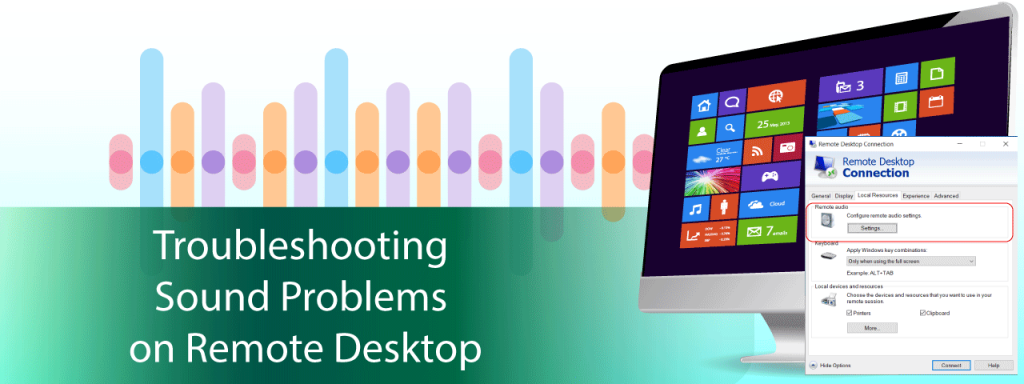Troubleshooting sound issues on a remote desktop
Audio is an important aspect of the remote desktop experience, allowing users to communicate, listen to music and other audio files, and gain a complete understanding of the remote computer experience. Many users encounter problems when trying to independently configure the operation of remote equipment. High Figure Team is always ready to help with solving audio issues on remote desktop. We have prepared a small guide in which we will tell you more about the problems and solutions. If you have any difficulties, please contact our company for help.
Understanding Remote Desktop Sound Issues
Audio is an integral part of the remote desktop experience, allowing users to communicate. Unfortunately, remote desktop environments can experience various audio issues that have a negative impact on the user experience and performance. If remote desktop audio is not working, this may be due to the following problems:
- Complete absence of sound. Users do not hear any sounds from the remote computer.
- Distorted sound. Audio signals are interrupted, noisy, or otherwise distorted.
- Audio delay. Audio displays with delays or does not sync with video.
- Quality inconsistencies. The quality of audio transmission largely depends on the selected application and service.
Other audio problems include problems with the hardware itself. Delayed sounds make working on a remote desktop unproductive, preventing you from getting all the information you need to work.
Promptly addressing audio issues can improve the user experience and make the remote desktop experience more comfortable and efficient. High Figure Team will help solve your problems, regardless of complexity. Fixing audio issues results in better productivity for users as they will be able to communicate without any problems. You will be able to listen to audio and work without any problems.
Identifying Sound Issues on a Remote Desktop
If sound is not coming through the remote desktop, this could be due to many problems. Common signs of audio problems include:
- complete silence;
- distorted or delayed sound;
- unstable sound quality;
- problems with the microphone;
- background noise.
You can use the built-in audio testing tools to test audio on your remote desktop. They allow you to check the functionality of the audio system. Windows Event Viewer provides valuable information about audio driver errors or conflicts.
You can troubleshoot sound problems on remote desktop using different methods. First, it is important to carefully check your settings and make sure that the sound is enabled on both computers. It is necessary to update the drivers, check the network connection, and the functionality of the programs.
Troubleshooting Steps for Common Sound Issues
Now let’s look at the most common breakdowns and methods for dealing with them:
- No sound output from remote desktop. Check the audio settings on the local and remote computer. Restart all audio services and ensure that audio is redirected correctly.
- Choppy or distorted sound playback. Reduce audio quality to use available resources when your Internet connection is slow. Check the stability of your network connection and update drivers if necessary. Close interfering background applications.
- Delayed or lagging sound transmission. Reduce sound quality, optimize the network and distribute used resources.
- Inconsistent sound quality across different applications. If the sound quality is unstable, adjust your applications and software settings to ensure the remote desktop works correctly.
If other problems occur, try connecting a different microphone and check its functionality. If none of the methods works, contact our team for help.
Troubleshooting Specific Remote Desktop Solutions
Problems with the sound of the remote computer may be related to specific connections:
- RDP (Remote Desktop Protocol) connections. Make sure all audio settings are set in local settings, add firewall exceptions.
- Citrix Virtual Apps and Desktops. Go to settings and enable audio redirection. Specify the correct audio devices. Make sure you are using computer audio.
- VNC (Virtual Network Computing) connections. Make sure your VNC client supports audio redirection. Check your firewall configurations and rules.
If there is no sound from the remote desktop connection, then you should carefully read the connection settings. If any difficulties arise, please contact our professionals.
Advanced Troubleshooting Techniques
There are also professional methods for solving remote desktop audio problems. Among them:
- using network monitoring tools to analyze latency and throughput;
- research into compatibility problems of hardware, software and drivers;
- eliminating conflicts between drivers and software;
- using registry settings to set the required configurations.
All of these methods for solving sound issues on remote desktop require an understanding of the operating features of the hardware and software. If you have no experience in this, trust our professionals.
Security Considerations in Troubleshooting Remote Desktop Sound Issues
When solving any problems on a remote computer, it is very important to take care of security. Minimize remote access and use different authentication methods. Use encrypted connections for sensitive data. Follow privacy rules and ensure the protection of users’ personal data.
Preventive Measures to Avoid Future Sound Issues
It’s important to be proactive to avoid common audio problems on a remote computer:
- regularly check the audio equipment on the remote computer;
- update sound drivers and software;
- use sound monitoring systems;
- train users.
By using preventative measures, you can avoid audio problems and ensure high-quality remote work.
Good and high-quality sound is the key to productive work of remote teams. It is important to use preventive maintenance methods and contact a professional if any problems arise. The High Figure Team is ready to provide support in setting up remote audio.
